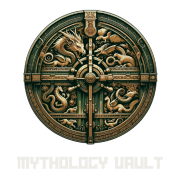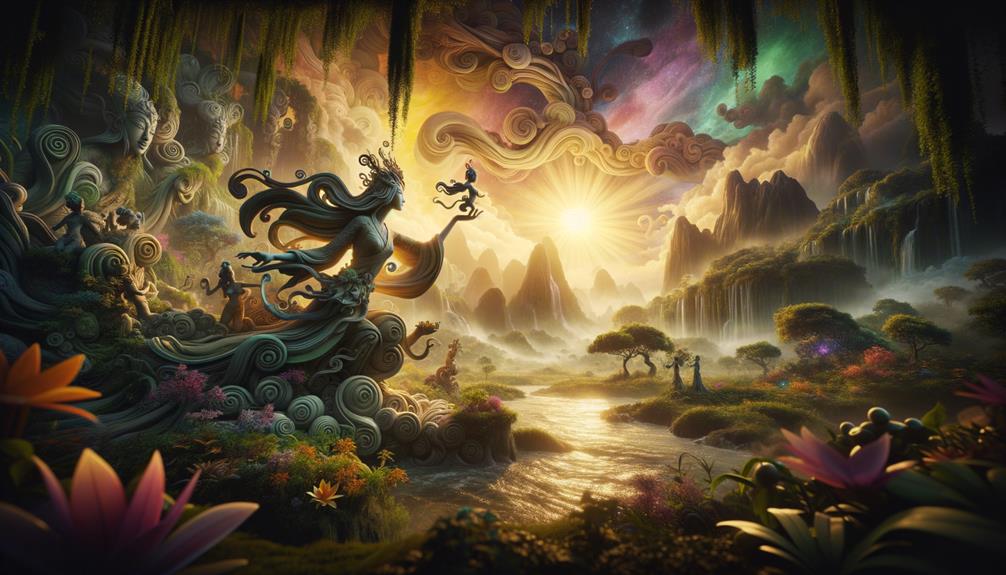Nu Gua emerges as a masterful sculptor, meticulously shaping human figures from clay, infusing each form with vibrant life. Her delicate touch wove intricate patterns of order and equilibrium. Standing as a profound symbol of cosmic harmony, she crafted existence itself, bridging realms divine and mortal. Each meticulously molded figure embodied societal balance and interconnectedness. Nu Gua's creations laid the foundations for customs and norms that still reverberate through our modern world. Every step of her journey whispers ancient wisdom, boundless creativity, and an eternal ebb and flow between light and darkness. This timeless tale holds profound depths yet to be unearthed and celebrated.
Nuwa's Role in Mythology
In Chinese mythology, Nuwa stands tall as the creator who formed humanity from mud and repaired the damaged heavens. As a pivotal figure in creation stories, she symbolizes humanity's beginnings and the intricate societal bonds that unite us. Her serpentine lower half marks her as an extraordinary being, straddling the realms of earth and the divine.
Nuwa's act of molding humans from clay wasn't merely a way to ease loneliness; it mirrored the hierarchical structure of Chinese society. Each sculpted figure represented different facets and classes within civilization. This creative act cemented her role as a deity intimately tied to the human experience.
Furthermore, Nuwa introduced marriage customs, instilling order and equilibrium in the cosmos. By promoting fertility and unity, she ensured life's continuation and harmony among humans. Her actions highlighted the importance of balance, reinforcing her role as a selfless protector dedicated to the greater good – a critical figure in Chinese mythology.
Nuwa wasn't just shaping clay; she was shaping society. Her creation of humans mirrored China's social hierarchy, each figure representing different classes and roles. It tied her divinity to the human experience – an intimate connection few deities share.
And Nuwa didn't stop there. She established marriage traditions, promoting unity, fertility, and cosmic equilibrium. This protector deity ensured life's continuity and societal harmony through her actions. Balance formed the core of her mythology, and she sacrificed for that balance, cementing her legendary status.
The Process of Creation
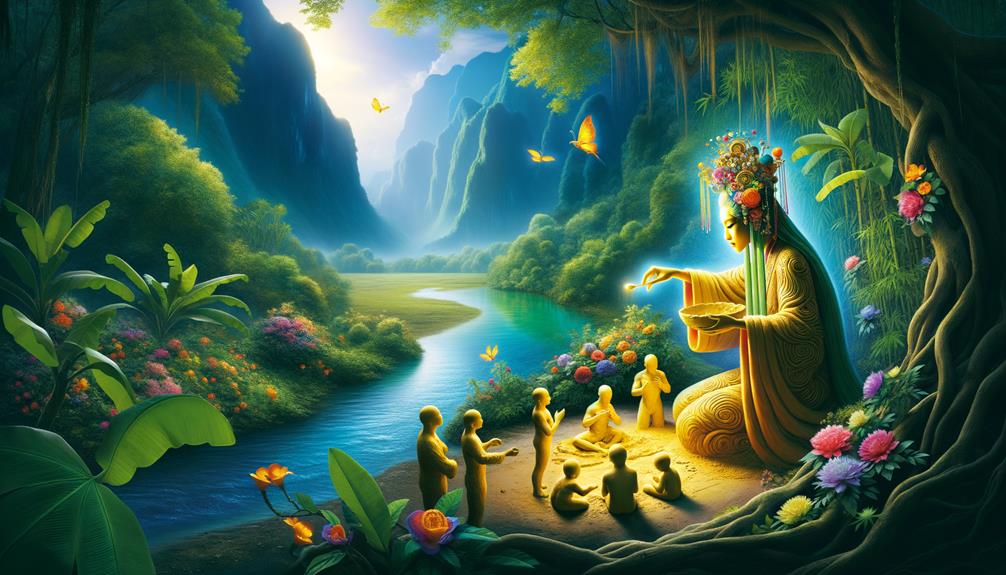
Nu Gua meticulously shaped the first humans from earth, breathing life into their clay forms. Her loneliness inspired this creation process—a deep yearning for companionship that only beings of her own making could fulfill.
With each mud figure she sculpted, Nu Gua infused a piece of herself, an intimate connection between humanity and the earth. Her breath wasn't mere air but a divine spark, awakening their existence. This gift embodied the goddess's compassion for a world filled with living beings.
Nu Gua's creations weren't lifeless statues but living, breathing companions born from her powerful yet nurturing hands. Humanity's origins trace back to this loving deity's profound desire for connection.
Symbolism and Significance
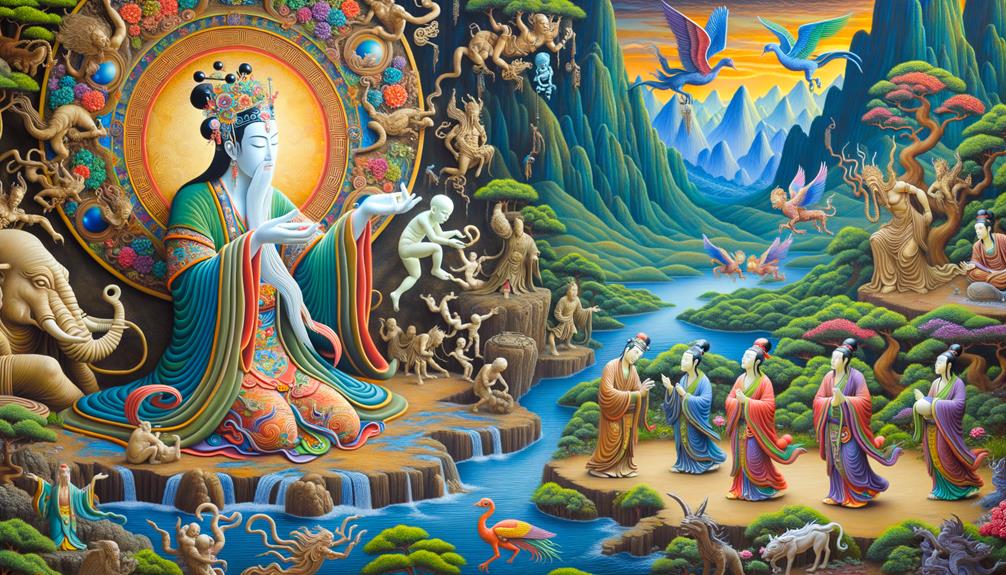
Nu Gua's creation of human beings from clay carries profound symbolism of cosmic order and harmony. This myth transcends the origin story, reflecting her role in shaping human existence and societal structures – a cultural legacy that continues influencing us today. Her molding of clay represents establishing universal equilibrium, with humans as manifestations of that delicate balance. The myth resonates deeply, epitomizing how her actions shaped our world.
Creation and Cosmic Order
Nu Gua's act of molding humans from mud represents her divine role in shaping cosmic harmony. As she sculpted each figure, she didn't merely breathe life; she wove the very essence of existence. In Chinese mythology, Nu Gua's creation of humanity showcases her immense power and deep ties to our origins. Her clay-covered hands crafted more than physical forms—they shaped societal equilibrium.
| Symbol | Emotion Evoked |
|---|---|
| Mud | Origins |
| Creation | Wonder |
| Balance | Serenity |
Nu Gua stands as a divine force, embodying cosmic order through her actions echoing across ages. By shaping humanity, she laid a foundation of balance and societal structure, assigning each person their rightful place. Her mythological narrative guides our understanding of the cosmos. Every sculpted ripple in clay breathed a life, a destiny she lovingly molded. Through divine craftsmanship, Nu Gua formed the chaotic void, illustrating creation's profound interconnectedness and cosmic order. Her story reflects the intricate dance between divine power and human existence.
Duality and Balance
Nu Gua's creation of humanity symbolizes the interconnectedness and harmony found in Chinese mythology. By uniting with Fuxi, Nu Gua represents the relationship between male and female energies, illustrating creation as a balanced dance.
Picture Nu Gua's divine hands artistically blending earthly elements, breathing life into clay figures. This sacred act emphasizes balance, seamlessly integrating light and dark, heaven and earth, male and female energies. Nu Gua reminds us that existence is interconnected, and harmony is vital for the universe's wellbeing.
The duality she embodies is a complementary force, akin to yin and yang. Her role in humanity's creation serves as a timeless reminder of the necessity of cosmic balance and harmony within Chinese mythology's rich tapestry.
Cultural Legacy and Influence
In Chinese mythology, Nu Gua holds profound significance as the creator goddess who shaped humans from clay. Her story transcends mere creation; it symbolizes societal values like balance, fertility, and harmony.
Nu Gua and Fuxi's union represents the complementary forces of yin and yang, male and female. This concept of cosmic balance permeates Chinese culture, highlighting its pivotal role. Their narrative provides insight into humanity's origins while underscoring the importance of equilibrium.
Nu Gua's legacy:
- Founding myth explaining the human race's beginnings
- Personification of the primal couple, emphasizing unity
- Embodiment of creation, fertility, and societal customs
- Symbolism of balance within the universe
- Connection to the cosmic egg motif, representing life's origin
Nu Gua's enduring myth illustrates how ancient stories shape perspectives on existence and our place in the world.
Fuxi's Assistance
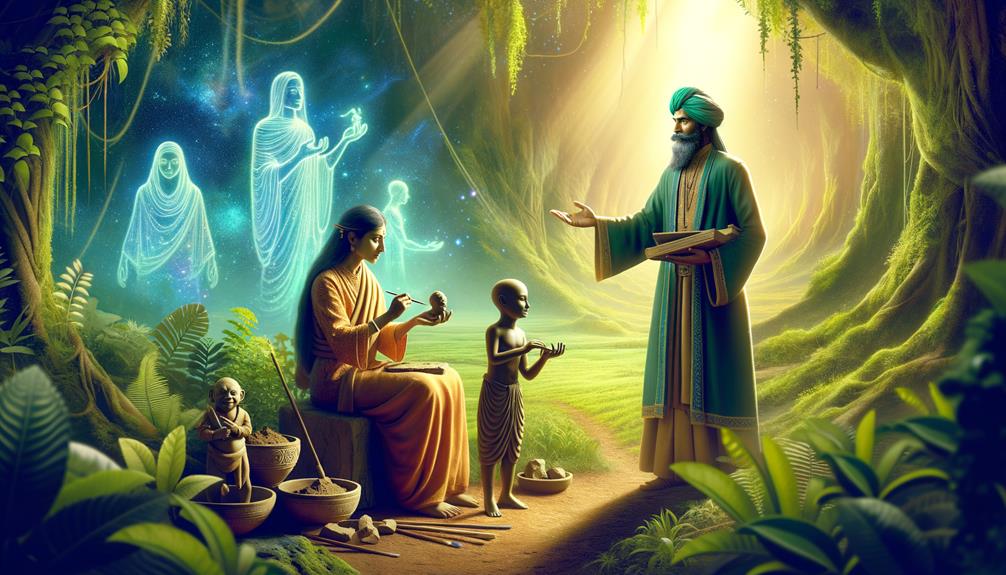
Fuxi's unwavering dedication to Nu Gua in crafting humans from mud highlights their profound connection and shared divine purpose. In ancient Chinese creation tales, Fuxi and Nu Gua stand as monumental figures. As siblings, they embodied the union of heaven and earth, representing the primal forces that shaped our world. Together, they breathed life into the first humans, lovingly sculpting them from clay.
Fuxi's assistance wasn't a mere obligation; it stemmed from a deep comprehension of their shared mission to repopulate the Earth. The intertwined pair, with human upper bodies and snake tails, witnessed the desolation of a lifeless world and resolved to remedy it. Their hybrid forms symbolize their divine nature and integral roles in Chinese mythology.
Their creations scattered across the world, ensuring humanity's survival and proliferation. In those early days, each figure they molded reflected their resolute ingenuity, cementing their status as revered architects of human existence.
Impact on Society
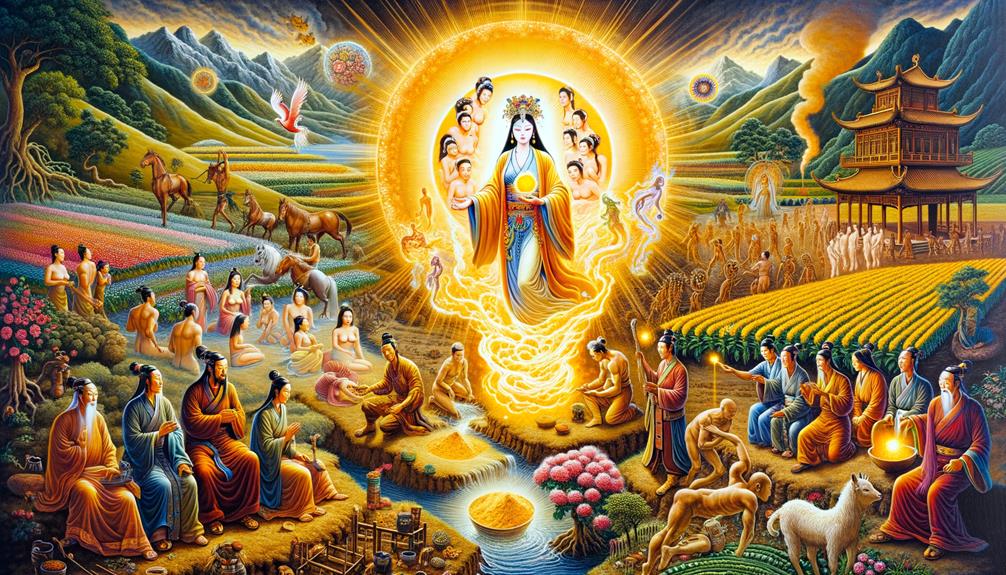
Nu Gua's myth of shaping humanity from clay transcends individuals; it lays the groundwork for societal values. Her story emphasizes gender balance and interconnectedness, themes echoed throughout Chinese art and literature. Embodying the nurturing Great Mother, Nu Gua's influence reminds us of the sacred unity binding society.
Cultural Symbolism and Myths
In the rich world of Chinese mythology, Nu Gua molding humans from mud symbolizes unity between heaven, earth, and humanity. Her story reflects cultural values ingrained in Chinese society.
Nu Gua, a revered figure, represents wisdom and creativity. Shaping people from clay signifies humanity's birth while highlighting social order and marriage traditions. The myth teaches that harmony maintains relationships and societal structures.
- Nu Gua's human creation: Interconnectedness between the divine and earthly realms.
- Balance and harmony: Core Chinese cultural principles, exemplified through her acts.
- Marriage customs: Influenced by Nu Gua's role in bringing people together.
- Social order: Fostered through the unity she creates among humans.
- Wisdom and creativity: Nu Gua's embodied attributes, inspiring generations.
Nu Gua's story serves as a foundational pillar, guiding societal norms and values. Her creation of humanity reflects the enduring significance of balance, harmony, and wisdom in Chinese culture.
Gender Roles and Equality
Nu Gua's myth shakes societal norms, depicting a realm where female ingenuity shapes human existence itself. As we ponder her divine creation act, Nu Gua redefines gender roles, placing women at humanity's origin. Her creative hands molded people from earth, underscoring the innate equality of all genders at birth.
Nu Gua's tale isn't just a story; it's a profound narrative advocating balance and synergy between masculine and feminine energies. Her creation showcases a world prioritizing cooperation and partnership, where no gender overshadows but complements the other. This harmony represents societal unity, inviting us to view gender roles through an egalitarian, mutually respectful lens.
Centuries later, Nu Gua's myth resonates, reminding us that our foundation rests on shared power and cooperation. Her legacy inspires inclusivity, fostering a society celebrating diverse gender roles.
Nuwa in Modern Culture
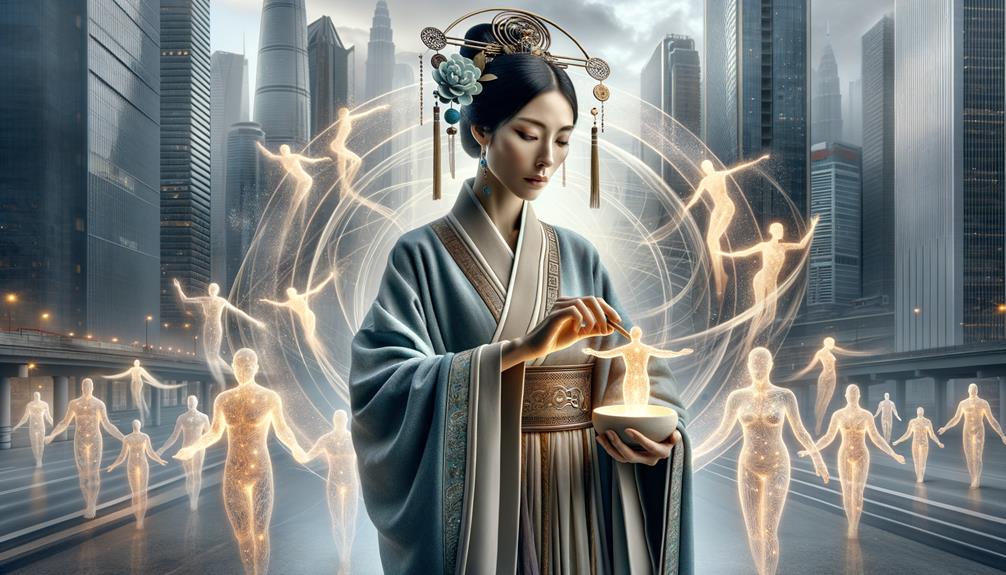
Nuwa's mythological influence resonates powerfully in contemporary culture, reflecting humanity's eternal pursuit of equilibrium and creativity. Her ancient stories inspire artistic and literary expressions across China, showcasing her enduring relevance within our shared consciousness. Transcending time, Nuwa's legacy captivates audiences worldwide.
In modern times, Nuwa symbolizes balance and harmony. Environmental campaigns prominently feature her image, highlighting her connection to nature and creation – a parallel to our current efforts to protect and restore the environment.
Contemporary Chinese art and literature prominently center on Nuwa's figure. Environmental organizations leverage her image to promote sustainable practices. Cultural events and ceremonies celebrate her role in Chinese folklore. She represents equilibrium and unity in modern narratives. Beyond cultural boundaries, her stories hold universal appeal.
Nuwa's legacy underscores the timeless allure of ancient myths. Through cultural events, her significance endures, reminding us of the archetypal symbols woven into her narrative. As we navigate modern challenges, Nuwa guides us towards balance and harmony, just as she did in the ancient tales.
Frequently Asked Questions
How Did Nu Gua Make Human Beings?
I sculpted unique human figures from yellow clay found along riverbanks, breathing life into each one. This symbolic act revealed my nurturing nature and creative abilities, marking the mythological origins of humanity.
Did Nüwa Create the World?
Nuwa didn't create the world from scratch; her role focused on repairing the heavens and molding humanity from clay. Her narrative embodies a hero's journey, healing cosmic rifts and breathing life into clay figurines – reflecting resilience and the profound symbolism deeply rooted in Chinese mythology.
Did Pangu Create Humans?
Pangu didn't shape humanity from the primordial clay; his legendary journey focused on separating the heavens and earth, forming our world's foundations. While his cosmic deeds paved the way, it was another's hands that eventually molded humankind.
How Were Humans Created in Chinese Mythology?
In Chinese folklore, humans emerged from dirt and mud, reflecting societal hierarchies. Nu Gua, grappling with solitude, shaped them with Fuxi's assistance. Interestingly, 60% find mythological origin narratives captivating, unveiling our enduring quest for comprehension.
